ou can hurt with your words but sometimes you can hurt more with your silence.
Friday, January 30, 2009
Saturday, January 24, 2009
Lonely Daffy
 I didn't plant any daffodils last fall but did have this one come up from some I had planted before. It was the only one. Daffodils are one of my favorite flowers but they don't like to do well here in the desert where the wind has a habit of burying them to deep with sand for them do to well after the first year.
I didn't plant any daffodils last fall but did have this one come up from some I had planted before. It was the only one. Daffodils are one of my favorite flowers but they don't like to do well here in the desert where the wind has a habit of burying them to deep with sand for them do to well after the first year.Turn Signals and Brake Lights: Can It Be Done, Elegantly?
 [Steyr Waffenrad c.1925; image via radlmax]
[Steyr Waffenrad c.1925; image via radlmax]I know that I am not the first to bring this up. But when I see details like this from 85 years ago, I wonder what it would take to develop a modern, elegant mechanism whereby squeezing the brake levers on a bicycle would activate a flashing tail light. And furthermore, what it would take to develop an unencumbered, easy to use system that allowed for turn signal lights to be displayed without the cyclist having to use hand signals - which, from personal experience, I know are not always visible to motorists and are not always possible to execute.
While various turn signal and brake light kits for bicycles already exist, they are not popular. And I suspect the reason, is that the currently available ones either turn the bicycle into a science project monster covered with a mess of wires and gadgets, or are just not convenient to use. But what about a simple, attractive design that would integrate with a classic bicycle seamlessly? a design that a "normal person" (i.e. not someone who is into gadgetry) would find appealing and easy use? I find it surprising that various labs out there are developing prototypes of all sorts of crazy futuristic bikes without drivetrains or spoked wheels, yet the idea of brake and turn lights does not seem interesting or useful enough for anybody to pursue seriously.
 If I had the funds and influence to do so, I would love to sponsor a contest with precisely this goal in mind - but unfortunately, I don't think that knitted hats and the "honor" of being featured on Lovely Bicycle alone have sufficient pull to convince electrical engineers to spend their time working on such a project. If anybody in the industry is interested in getting involved as a sponsor, please do get in touch.
If I had the funds and influence to do so, I would love to sponsor a contest with precisely this goal in mind - but unfortunately, I don't think that knitted hats and the "honor" of being featured on Lovely Bicycle alone have sufficient pull to convince electrical engineers to spend their time working on such a project. If anybody in the industry is interested in getting involved as a sponsor, please do get in touch. What are your thoughts on this? If designed to integrate with the bicycle seamlessly, would you find a brake light and turn signal system useful, or not particularly? And in the event that you already have one installed on your bike, which one is it and how is it working out for you?
Thursday, January 22, 2009
Rare Old Beast: a Very Early Brompton

Brompton folding bikes have remained virtually unchanged since they entered into production in the late 1980s. But before that happened, there was a small pilot run and the machines from this early batch were just a tad different. Only several hundred of these were made. Two of those recently ended up passing through Harris Cyclery on their way to the Brompton museum. And one of those I had the opportunity to photograph and ride. Pictured here is the 358th Brompton ever produced. Red and black 3-speed with upright handlebars, dynamo lighting, rear rack and fenders.
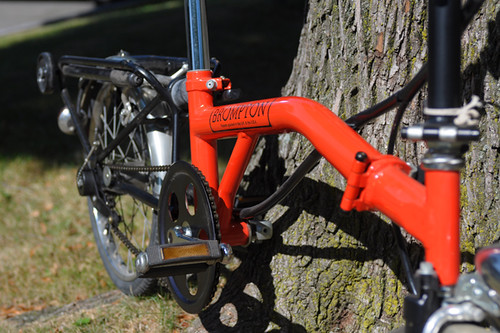
The most striking difference between the Brompton we know today and this early model is the "humpback" frame construction. As the Brompton history page explains it, "this feature had come about for the simple reason that standard pipe-bending tools could not produce the gentle radius desired. Change would only come with expensive retooling." By the time the bikes went into full production, the capital investment required for this had been secured and the bend of the main tube became more elegant.
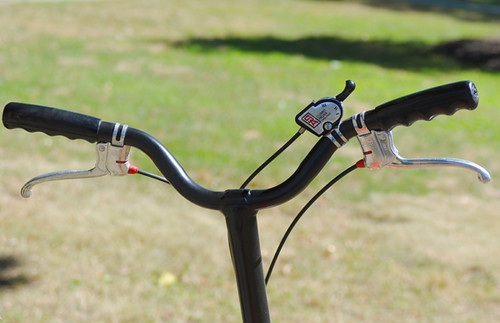
Other differences are more subtle. For instance, the handlebars are welded(?) to the stem.
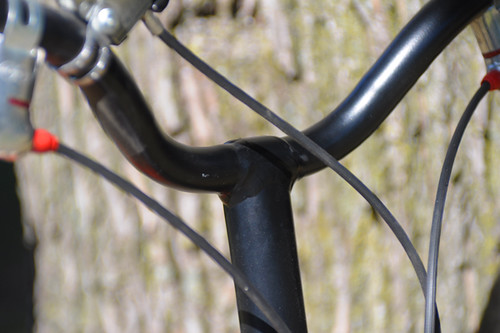
Here is a close-up. I take it this means the early handlebars were steel.
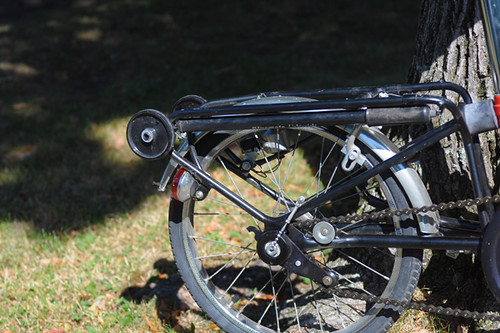
Likewise, the rear carrier is welded to the rear triangle.
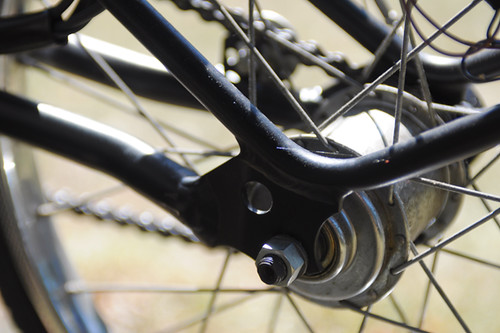
Like so.
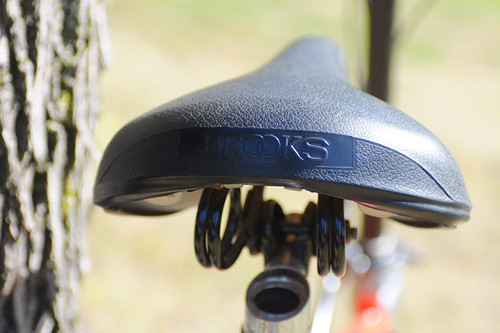
The bike comes with a wide, sprungplastic Brooks saddle.
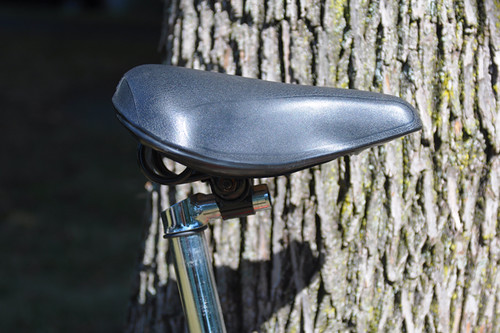
Fitted onto a set-forward seatpost.
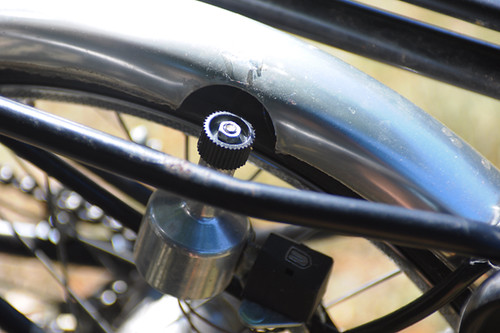
The dynamo lighting functions via a bottle generator on the rear wheel. The rear fender has a special cut-out to accommodate it.
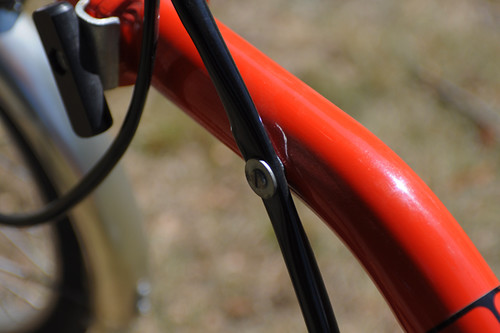
The cable routing is interesting.
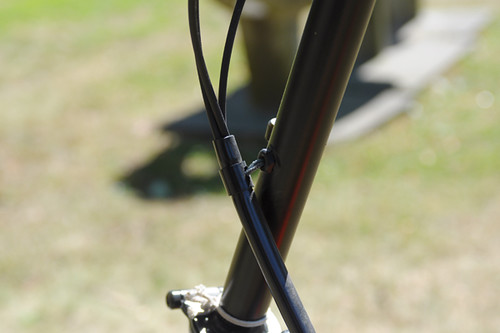
If I understand this correctly, it appears that several cables are gathered into the same housing and secured to the frame and stem at various points to facilitate the fold?
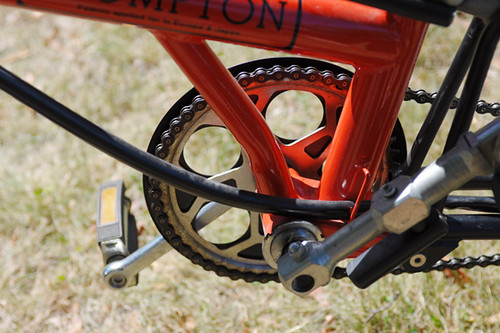
Here it is passing over the bottom bracket.
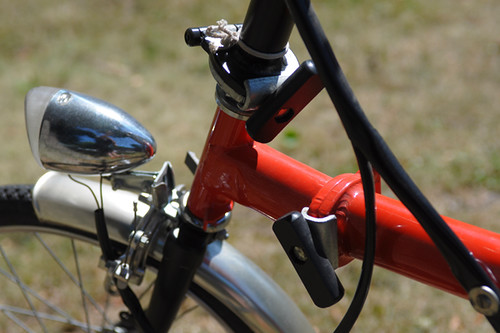
The fold itself is mostly identical. Same process, with similar bolts on the frame and stem as on the current production model.
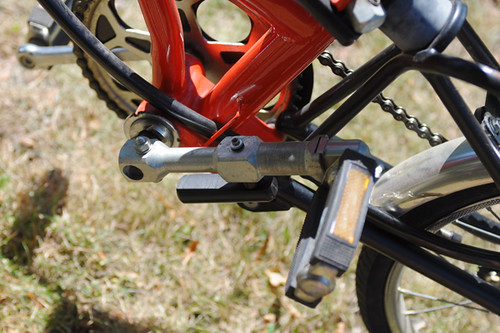
Only the pedal fold is different.
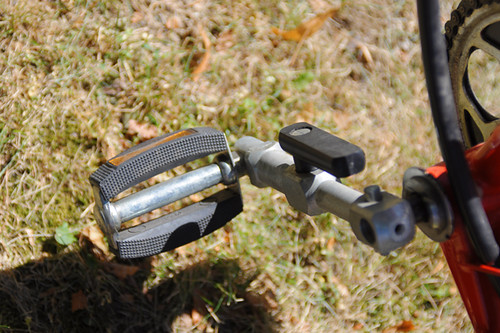
Levers are involved; it is more complicated and bulky than the current snap-fold.
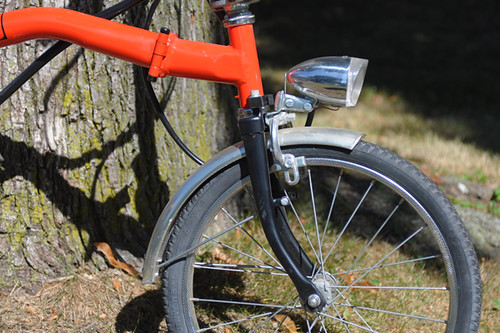
Finally, it looks to me as if the frame construction itself is different in places - the way the tubes are joined.The other differences are mainly in the components. The retro lights. The fender stay attachment. There is no front block system, and instead some of the early models were fitted with front racks. Brompton experts will no doubt notice a myriad of other differences that I haven't picked up on. As far as weight, the bicycle felt a bit heavier to pick up than current production models built up with equivalent specs, but not by much.

I rode the older bicycle carefully and briefly - not wanting to ruin its pristine condition (it had barely been ridden by the previous owner). The first thing I noticed was that there was much less room in the "cockpit" compared to my own Brompton; it felt a bit cramped. The difference seemed too great to be explained by the older bike's saddle being more forward; it seemed that the frame itself was shorter. Later I asked about this at Harris and was told it was indeed the case. Unfortunately I had no time to measure the two bikes, but it appears that when they got rid of the bend in the main tube, they also lengthened it.
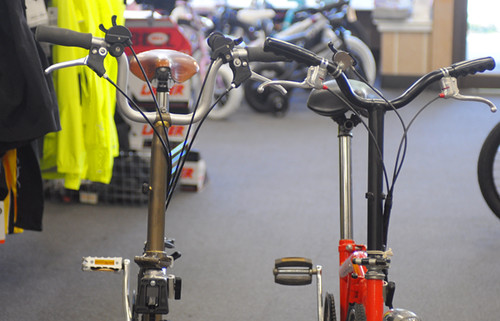
However, the front-end handling of the older bike felt very similar, if not identical to modern Bromptons. Overall, riding it felt like riding an older and more upright version of the same bike.Reading Brompton's history and hearing about it firsthand from those in the know, it is striking how little the bicycle has been tweaked since its initial development. Aside from straightening out the bend after the pilot production run, they've mostly just worked on getting the weight down a bit and improving the components. The fold and the handling have remained the same.

For locals who'd like to see the pair of early Bromptons, they will remain on temporary display at Harris Cyclery until September. Many thanks for the opportunity to photograph and ride the #358! You can view more close-ups of ithere, and Elton Pope-Lance has photographed both bicycles here.
Wednesday, January 21, 2009
Grand Canyon :: Kaibab Trail to Cedar Ridge
Our first foray into the Grand Canyon on Monday (April 12th) was a relatively short one; only a mile and a half in length, but it is also had a descent of 1140 feet, starting at an elevation of 7200 feet on the rim and ending at 6060 feet at Cedar Ridge. And, of course, what goes down must also come up! It took us an hour and 15 minutes to make the descent. The trail was in fairly good condition, no snow or ice. But what amazed me was that it took us just 15 minutes longer to make the climb back to the top! And we stopped along the way. A lot. At almost every turn of the switchbacks!
The description of the trail was given as “Maintained dirt trail. Steep. Well defined. Little shade on trail, mostly from canyon walls and dependent on time of day.” That really doesn't do it justice. It's rocky in many places. It had some pretty high steps. It's very steep. It's strenuous. It's challenging. It was fun! Really.
 The view from the rim as we were starting out. It was a beautiful day. Sunshine. Blue skies. Cool temperatures just right for hiking with great company.
The view from the rim as we were starting out. It was a beautiful day. Sunshine. Blue skies. Cool temperatures just right for hiking with great company.
 Switchbacks as you come down from the rim.
Switchbacks as you come down from the rim.
 More switchbacks going down... did I mention that the trail was steep?
More switchbacks going down... did I mention that the trail was steep?
 Sue and Fred, taking a break. (Photos of them, and those taken by them, used with their permission.)
Sue and Fred, taking a break. (Photos of them, and those taken by them, used with their permission.)
 Behind me is the section of trail we had just come down, one of the easier sections, I might add. Of course, we were still going down. It didn't look so easy going back up! (Photo by Sue.)
Behind me is the section of trail we had just come down, one of the easier sections, I might add. Of course, we were still going down. It didn't look so easy going back up! (Photo by Sue.)
 Back on the trail. Still going down.
Back on the trail. Still going down.
 Another steep section showing the rugged condition of the trail. It was difficult to maintain your stride in these sections with the logs across the path.
Another steep section showing the rugged condition of the trail. It was difficult to maintain your stride in these sections with the logs across the path.
 Our destination is in sight! The Kaibab trail continues on past the ridge then winds it's way down the next peak, eventually reaching the river some six miles or more away.
Our destination is in sight! The Kaibab trail continues on past the ridge then winds it's way down the next peak, eventually reaching the river some six miles or more away.
On the way down we had encountered several spots of gusty wind along the trail where we just had to stand still to maintain our footing until the wind passed by. When we reached the ridge plateau, there was a light breeze blowing. It was warm in the sunshine. It was very nice. We walked on out to the end of the ridge, that “pile” of rocks in the center of the photo, and ate our lunch. The wind picked up a little so we moved to a more protected spot and waited for the wind to die down.
During a little lull, we decided to climb back to the flat area. At one particularly narrow spot, the wind came up fast and furious. Sue and I were caught in a gust of wind, I grabbed her arm, not only to steady myself but to steady her as well. We weren't sure that we could keep our footing. It was a bit of a scary moment, it passed, but not soon enough for either of us! If we had fallen off, the drop to the next level was only a few feet, but still, we were more than a little concerned. All of a sudden the wind stopped and we literally ran off of that ledge. With the helping hand of another hiker we scrambled up the last few rocks onto level ground and quickly made our way to a somewhat safer area to settle our nerves.
 Looking back at the section of trail that leads down to Cedar Ridge.
Looking back at the section of trail that leads down to Cedar Ridge.
 The final switchbacks going up to the rim. We're almost there! Thus far on my journey, this was the most challenging and difficult three-mile trek I've made. Was it worth it? Oh, yeah! Would I have made the trek if I had been alone? I'm not sure. I'm just glad that Sue and Fred were there to coax me along the trail. Thank you!
The final switchbacks going up to the rim. We're almost there! Thus far on my journey, this was the most challenging and difficult three-mile trek I've made. Was it worth it? Oh, yeah! Would I have made the trek if I had been alone? I'm not sure. I'm just glad that Sue and Fred were there to coax me along the trail. Thank you!
The description of the trail was given as “Maintained dirt trail. Steep. Well defined. Little shade on trail, mostly from canyon walls and dependent on time of day.” That really doesn't do it justice. It's rocky in many places. It had some pretty high steps. It's very steep. It's strenuous. It's challenging. It was fun! Really.
 The view from the rim as we were starting out. It was a beautiful day. Sunshine. Blue skies. Cool temperatures just right for hiking with great company.
The view from the rim as we were starting out. It was a beautiful day. Sunshine. Blue skies. Cool temperatures just right for hiking with great company. Switchbacks as you come down from the rim.
Switchbacks as you come down from the rim. More switchbacks going down... did I mention that the trail was steep?
More switchbacks going down... did I mention that the trail was steep? Sue and Fred, taking a break. (Photos of them, and those taken by them, used with their permission.)
Sue and Fred, taking a break. (Photos of them, and those taken by them, used with their permission.) Behind me is the section of trail we had just come down, one of the easier sections, I might add. Of course, we were still going down. It didn't look so easy going back up! (Photo by Sue.)
Behind me is the section of trail we had just come down, one of the easier sections, I might add. Of course, we were still going down. It didn't look so easy going back up! (Photo by Sue.) Back on the trail. Still going down.
Back on the trail. Still going down. Another steep section showing the rugged condition of the trail. It was difficult to maintain your stride in these sections with the logs across the path.
Another steep section showing the rugged condition of the trail. It was difficult to maintain your stride in these sections with the logs across the path. Our destination is in sight! The Kaibab trail continues on past the ridge then winds it's way down the next peak, eventually reaching the river some six miles or more away.
Our destination is in sight! The Kaibab trail continues on past the ridge then winds it's way down the next peak, eventually reaching the river some six miles or more away.On the way down we had encountered several spots of gusty wind along the trail where we just had to stand still to maintain our footing until the wind passed by. When we reached the ridge plateau, there was a light breeze blowing. It was warm in the sunshine. It was very nice. We walked on out to the end of the ridge, that “pile” of rocks in the center of the photo, and ate our lunch. The wind picked up a little so we moved to a more protected spot and waited for the wind to die down.
During a little lull, we decided to climb back to the flat area. At one particularly narrow spot, the wind came up fast and furious. Sue and I were caught in a gust of wind, I grabbed her arm, not only to steady myself but to steady her as well. We weren't sure that we could keep our footing. It was a bit of a scary moment, it passed, but not soon enough for either of us! If we had fallen off, the drop to the next level was only a few feet, but still, we were more than a little concerned. All of a sudden the wind stopped and we literally ran off of that ledge. With the helping hand of another hiker we scrambled up the last few rocks onto level ground and quickly made our way to a somewhat safer area to settle our nerves.
 Looking back at the section of trail that leads down to Cedar Ridge.
Looking back at the section of trail that leads down to Cedar Ridge. The final switchbacks going up to the rim. We're almost there! Thus far on my journey, this was the most challenging and difficult three-mile trek I've made. Was it worth it? Oh, yeah! Would I have made the trek if I had been alone? I'm not sure. I'm just glad that Sue and Fred were there to coax me along the trail. Thank you!
The final switchbacks going up to the rim. We're almost there! Thus far on my journey, this was the most challenging and difficult three-mile trek I've made. Was it worth it? Oh, yeah! Would I have made the trek if I had been alone? I'm not sure. I'm just glad that Sue and Fred were there to coax me along the trail. Thank you!
Saturday, January 17, 2009
More Glove Love: Convertible Mittens
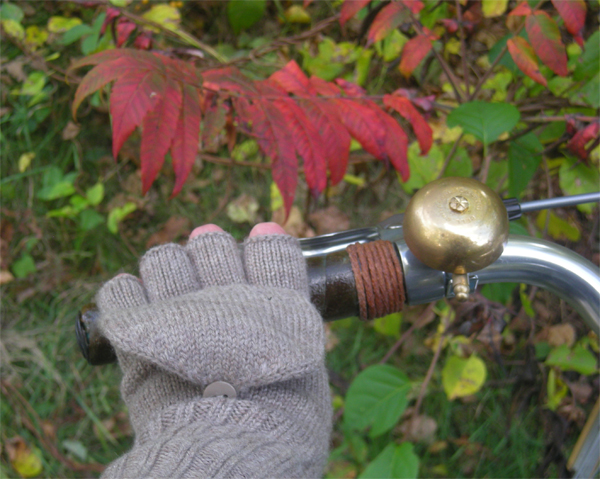 With the arrival of colder temperatures, my crochet cycling gloves were no longer cutting it. The Co-Habitant came to the rescue with a welcome gift: convertible mittens in a luxuriously soft wool. I love these things!
With the arrival of colder temperatures, my crochet cycling gloves were no longer cutting it. The Co-Habitant came to the rescue with a welcome gift: convertible mittens in a luxuriously soft wool. I love these things! The convertible mittens are basically fingerless gloves, with extra "mitten flaps" above the knuckles. The flaps can be unbuttoned and folded over the fingers to create mittens. The thumb is full-fingered. The Co-Habitant bought these at the Banana Republic outlet store. They were available in this heathery beige colour, and also in black. Apparently many mainstream apparel manufacturers now sell versions of these.
The convertible mittens are basically fingerless gloves, with extra "mitten flaps" above the knuckles. The flaps can be unbuttoned and folded over the fingers to create mittens. The thumb is full-fingered. The Co-Habitant bought these at the Banana Republic outlet store. They were available in this heathery beige colour, and also in black. Apparently many mainstream apparel manufacturers now sell versions of these.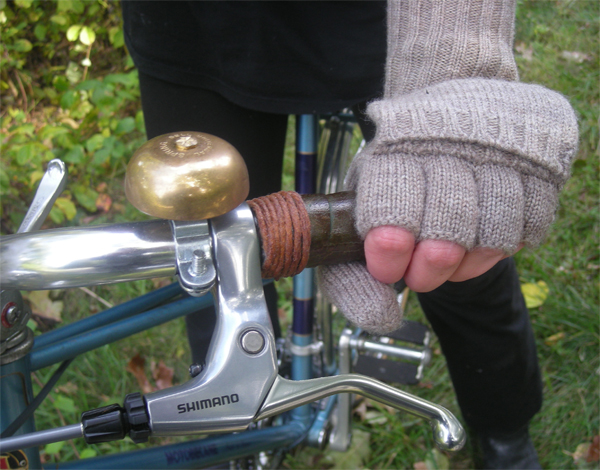 Aside from being clever and cute, these convertible mittens have several features that make them particularly suitable for cycling. Having the tips of the fingers exposed allows for optimal shifting, braking, and other machinations (such as camera clicks) that do not work so well when the finger tips are covered. The mitten mode makes them versatile as on/off the bike gloves. The 100% wool is great for warmth and moisture-wicking, and is not slippery on the handlebar grips.
Aside from being clever and cute, these convertible mittens have several features that make them particularly suitable for cycling. Having the tips of the fingers exposed allows for optimal shifting, braking, and other machinations (such as camera clicks) that do not work so well when the finger tips are covered. The mitten mode makes them versatile as on/off the bike gloves. The 100% wool is great for warmth and moisture-wicking, and is not slippery on the handlebar grips. An additional benefit, is that these gloves are extra long, which is excellent for protecting cyclists' wrists when they get exposed to the cold air due to the stretching of the arms to reach the handlebars. All those jackets, coats and sweaters with sleeves not long enough for cycling can be supplemented with long gloves like these.
An additional benefit, is that these gloves are extra long, which is excellent for protecting cyclists' wrists when they get exposed to the cold air due to the stretching of the arms to reach the handlebars. All those jackets, coats and sweaters with sleeves not long enough for cycling can be supplemented with long gloves like these. Convertible mittens in action. For those of you who knit, this might make a fun and worthwhile project (see instructions in pdf). Just make sure to use a soft 100% wool yarn (or wool and silk blend) and not an acrylic blend, and to make them extra long.
Convertible mittens in action. For those of you who knit, this might make a fun and worthwhile project (see instructions in pdf). Just make sure to use a soft 100% wool yarn (or wool and silk blend) and not an acrylic blend, and to make them extra long.
Friday, January 16, 2009
Summit Success
The weather was so good that I had a hard time coming down from Camp Muir. What was supposed to be an overnighter turned into a five-day excursion.
We arrived at Camp Muir on Wednesday despite unexpected rain, whiteout, snow and high winds. Making matters more interesting, the Muir Snowfield was a complete ice rink. That made skinning very difficult; crampons were, by far, the footwear of choice.
Like the snowfield, Camp Muir was all ice, which covered deep snow. There were three climbers camped in the public shelter waiting for the weather to break. They had attempted the ledges the night before, but left too late and had to turn back. The team reported firm/Styrofoam snow and ice all the way up the Cowlitz Glacier.
The weather improved that night, so we considered climbing the Nisqually Icefall the next day (Thursday). Like the other team, we too left late (1 PM) and due to the very warm temperatures prudently turned back upon spying a large avalanche tumble down the Nisqually Cleaver.
The three climbers in the Public Shelter decided to attempt the summit again, however this time via the Ingraham Direct. They climbed the right side of the Ingraham Glacier, and ran out of steam around 12,600 feet. Once again, they reported firm snow and ice, excellent cramponing.
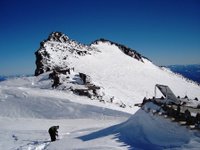 I spent the better part of Thursday afternoon and Friday (with Ted, famous sledder of the Muir Snowfield) digging buildings out around camp. As of Sunday the 12th, there was excellent access to the public shelter, pit toilet, emergency radio and NPS facilities.
I spent the better part of Thursday afternoon and Friday (with Ted, famous sledder of the Muir Snowfield) digging buildings out around camp. As of Sunday the 12th, there was excellent access to the public shelter, pit toilet, emergency radio and NPS facilities.
During the trip to Muir, I did take a jaunt to 12K on the Ingraham Glacier. We found firm snow and some ice (particularly near Cathedral Gap.) The most "crevasse free" path was on climbers right of the Ingraham Glacier. The center looked tempting, but had a HUGE crevasse around 11,700 feet. Though there has been a lot of snow this winter, I was impressed by the number of big crevasses still open on the Ingraham. And yes, the Ingraham Direct is in.
The high point of the weekend was that a climber reached the summit! That climber was a female soloist and she ascended the Nisqually Icecliff. Some consider this a major mountaineering feat on Mount Rainier. I’ll post more details on that trip soon!
We arrived at Camp Muir on Wednesday despite unexpected rain, whiteout, snow and high winds. Making matters more interesting, the Muir Snowfield was a complete ice rink. That made skinning very difficult; crampons were, by far, the footwear of choice.
Like the snowfield, Camp Muir was all ice, which covered deep snow. There were three climbers camped in the public shelter waiting for the weather to break. They had attempted the ledges the night before, but left too late and had to turn back. The team reported firm/Styrofoam snow and ice all the way up the Cowlitz Glacier.
The weather improved that night, so we considered climbing the Nisqually Icefall the next day (Thursday). Like the other team, we too left late (1 PM) and due to the very warm temperatures prudently turned back upon spying a large avalanche tumble down the Nisqually Cleaver.
The three climbers in the Public Shelter decided to attempt the summit again, however this time via the Ingraham Direct. They climbed the right side of the Ingraham Glacier, and ran out of steam around 12,600 feet. Once again, they reported firm snow and ice, excellent cramponing.
 I spent the better part of Thursday afternoon and Friday (with Ted, famous sledder of the Muir Snowfield) digging buildings out around camp. As of Sunday the 12th, there was excellent access to the public shelter, pit toilet, emergency radio and NPS facilities.
I spent the better part of Thursday afternoon and Friday (with Ted, famous sledder of the Muir Snowfield) digging buildings out around camp. As of Sunday the 12th, there was excellent access to the public shelter, pit toilet, emergency radio and NPS facilities.During the trip to Muir, I did take a jaunt to 12K on the Ingraham Glacier. We found firm snow and some ice (particularly near Cathedral Gap.) The most "crevasse free" path was on climbers right of the Ingraham Glacier. The center looked tempting, but had a HUGE crevasse around 11,700 feet. Though there has been a lot of snow this winter, I was impressed by the number of big crevasses still open on the Ingraham. And yes, the Ingraham Direct is in.
The high point of the weekend was that a climber reached the summit! That climber was a female soloist and she ascended the Nisqually Icecliff. Some consider this a major mountaineering feat on Mount Rainier. I’ll post more details on that trip soon!
Mating Damselflies, Swamp River

I paddled 13 miles on Swamp River yesterday and saw several critters but the highlight of the day was seeing all of the damselflies in the grasses and on the lily pads along the edge of the river. They are so small, most people probably wouldn’t even notice them. These little guys are only about an inch and a half long. Once you notice them, it’s hard to take your eyes off them (they are also quite hard to photograph, since they usually don’t sit still for very long). Adding to the difficulty was the wind. It was quite hard to capture these critters when the grasses were blowing around so much!
No Car, Must Travel
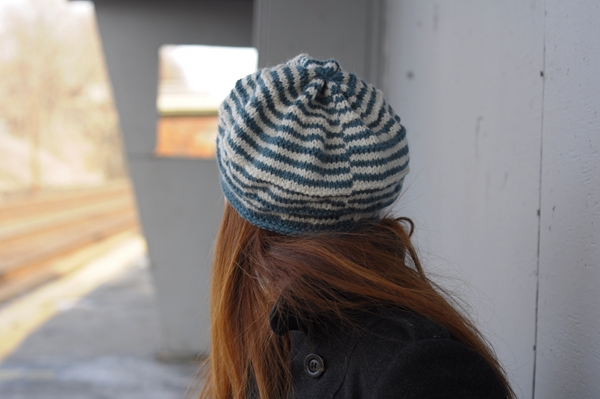 It has been two and a half months now without the car - pretty much the entire winter. For the most part we did not miss it. But now that the blizzards have subsided, it is time to get things done. We'll start going on photoshoots and other trips again soon, and there are other ways in which we will need it as well. This weekend was our first experiment with alternative options.
It has been two and a half months now without the car - pretty much the entire winter. For the most part we did not miss it. But now that the blizzards have subsided, it is time to get things done. We'll start going on photoshoots and other trips again soon, and there are other ways in which we will need it as well. This weekend was our first experiment with alternative options.I needed to get to Harris Cyclery (10 miles away) to drop off a bicycle along with some extra wheels and rims, since they'll be building new wheels for the Bella Ciao Superba prototype and also replacing the headset. After considering various options, we decided to take a taxi there with all the stuff, then take the commuter train back. Ordering the taxi, we specified that there would be two people plus a bicycle. Nevertheless, they sent a small sedan and great fun was had by all as we stuffed both me and the bicycle in the back seat. Still, we managed to fit everything in and arrived at Harris without incident. The fee for the taxi was reasonable.Total time for the trip, including calling and waiting for a taxi, wrangling in the bicycle, and the drive itself: 1 hour. Had we rented a car, it probably would have taken longer than the taxi, as a result of having to first go and get the rental.Had we driven our own car, it would have taken 30 minutes.
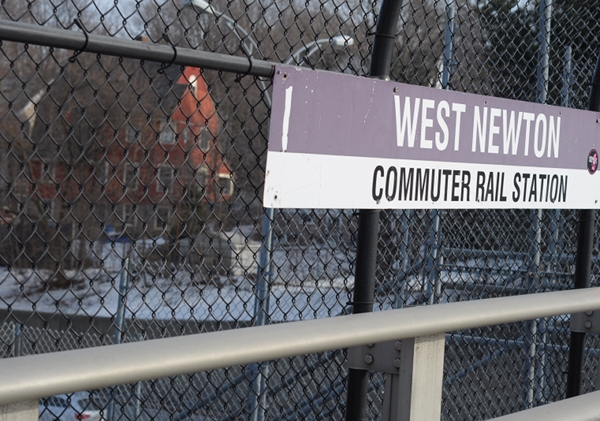 After getting done everything that we needed done, we had several hours to kill before heading back. The Saturday train schedule limited our choice for when to travel considerably: There was basically one train in the early afternoon and another late at night. So we test rode some Moultons and wandered around the three shops on the Main street, beforeheading for the Commuter Rail station.
After getting done everything that we needed done, we had several hours to kill before heading back. The Saturday train schedule limited our choice for when to travel considerably: There was basically one train in the early afternoon and another late at night. So we test rode some Moultons and wandered around the three shops on the Main street, beforeheading for the Commuter Rail station.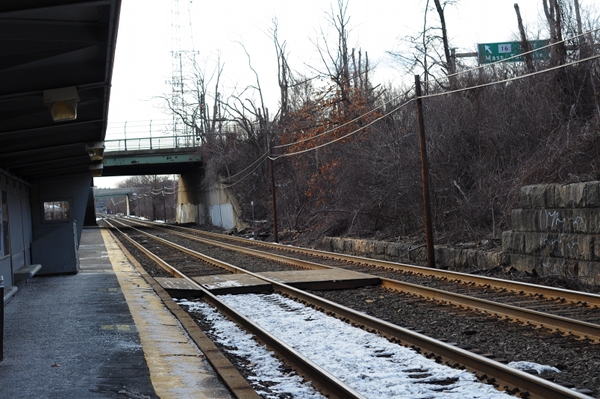 We arrived several minutes early. The station is outdoors and the train was 7 minutes late. In freezing temperatures, that wait is more difficult to endure than it sounds. The other people on the platform looked miserable as they paced back and forth to keep warm and cursed the train's (apparently habitual) lateness.
We arrived several minutes early. The station is outdoors and the train was 7 minutes late. In freezing temperatures, that wait is more difficult to endure than it sounds. The other people on the platform looked miserable as they paced back and forth to keep warm and cursed the train's (apparently habitual) lateness.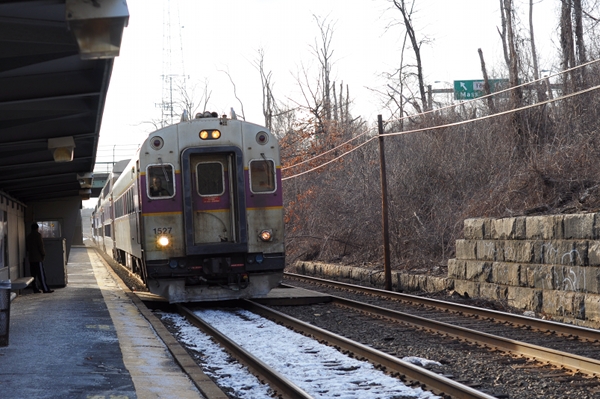 But finally it arrived, and thankfully it was warm inside. The numbness in my face began to subside as we headed toward Boston. Once in the city, we transferred to the subway, then walked home from the station.
But finally it arrived, and thankfully it was warm inside. The numbness in my face began to subside as we headed toward Boston. Once in the city, we transferred to the subway, then walked home from the station.Total time for the trip, including waiting for the commuter train, transferring onto the subway line and walking home: 1 hour 15 minutes. But if we include the time wasted because of the spotty train schedule, then the return trip was really over 3 hours. Had we driven our own car, it would have been 30 minutes.In other words, an activity that would have taken us a total of two hours had we used our private vehicle, wound up taking up half of our day - which is not exactly a success story. Next time we will give car rental or zipcar a go, but it is too bad that public transportation in the greater Boston area is not more convenient.
Thursday, January 15, 2009
Don Garlits Museum of Drag Racing

Since it was an extra long weekend, we both were able to pick a thing to go and see/do and then we picked one together. My pick was the Drag Racing Museum that was nearby. I have been excited about this museum since we got here. I love all things to do with cool cars of any type. Nathan is a little less enthusiastic about them. When it comes to them being in a museum, it works out perfectly though because it is the only kinds of museums that I want to spend as long in the museum as Nathan does.

While he reads every single written word in the museum, I look at every single thing on the car that I think is cool. Then I take pictures of every single thing I think is cool. Which means I end up with way more pictures than is reasonable. Then I go home and look at them...over and over again. I really love cool cars.
This particular museum was founded by Big Daddy Don Garlits. His bio is extremely impressive. His cars were extremely impressive. The museum was extremely impressive. We had a great time visiting this place!

There is not a lot of information about the museum online, so I did not know just how much would be here. I was hoping there would be enough that we would feel it was worth the time and money. It went way beyond that, having far more there than we expected and it was laid out very nicely making it very easy to learn a lot along the way. Alongside of the displays were posters, signage and even movie clips.

There was information about the drivers, some of which were women. There were stories about the times when the reality of how dangerous this is reared its ugly head. At one point Garlits had an injury that sliced through his foot, tearing his foot in half. One of the outcomes of that injury was some engineering design changes such as moving the engine behind the driver instead of in front of the driver. There were pieces and parts of the cars that had been in accidents.

And of course there were rows and rows of the awesome cars! We highly recommend this neat museum if you are in the Ocala area. There are two museums on site, I will come back and share about the other one after I get the pictures cropped and edited. That might take days because I took even more pictures at the other museum! Living the life in interesting Florida!
Tuesday, January 13, 2009
In Trinidad: Oscar and his world
While in Trinidad I had the opportunity to meet Oscar and I was humbly honoured to see a part of his world that he so cherishes.
 Oscar lives in the old centre of Trinidad. You can quickly recognise him pushing his hand cart or sitting on top of it as he peddles fresh fruits from corner to corner in Trinidad. However, Oscar is not just your quintessential fruit vendor.
Oscar lives in the old centre of Trinidad. You can quickly recognise him pushing his hand cart or sitting on top of it as he peddles fresh fruits from corner to corner in Trinidad. However, Oscar is not just your quintessential fruit vendor.
We first saw Oscar at the Plaza Mayor. He is super-duper friendly. He doesn’t speak English at all but I understand and speak a wee bit Spanish accompanied with the vital hand language of course, haha, so that made communication a bit easier. However, at Plaza Mayor we just smiled at Oscar and didn’t really engage in a talk with him.
Later, he found us again sitting in a small park in front of the Church and Monastery of Saint Francis. He gave us a warm familiar smile. He then put down his wagon on the street, walked up to us and started a conversation. Interestingly, we managed to have a decent chat in my oh-so horrible almost unintelligible Spanish. He then sat down beside me and asked where we are from and I said—Holland. The Netherlands.
His face shining, he said, ‘Ahhh Holanda! Un momento...’
Oscar then took out a plastic pouch in his bag and opened it. I was quite curious what he wanted to show us? And then slowly he took out his precious collection, a bunch of pictures and letters. They were from his friends and acquaintances all over the world. From tourists passing by Trinidad. Tourists from the Netherlands as well. Some of the pictures he even looked younger and a few of the letters were dated old.
He then spoke, with pride, about these friends.
Blondine and I were a bit surprised and at the same time charmed by this friendly old man. I on the other hand was so touched. He showed us a part of his world and the friendships he cherished with these people. Tourists, visitors, they were just like Blondine and I, passing through Trinidad.


 It also seems that he carries the pouch of pictures and letters with him every single day as he peddles fruits in the old centre of Trinidad. I have very strong suspicions that Oscar uses his fruit peddling activity as a front; simply an excuse to meet new (foreign) friends.
It also seems that he carries the pouch of pictures and letters with him every single day as he peddles fruits in the old centre of Trinidad. I have very strong suspicions that Oscar uses his fruit peddling activity as a front; simply an excuse to meet new (foreign) friends.
His world revolves around meeting people from different parts of the world and he cherishes this experience deeply. Such a very sweet man.
I didn’t have anything to give to Oscar, such as a picture and a letter, but I have this blog entry to dedicate to him.
 Oscar lives in the old centre of Trinidad. You can quickly recognise him pushing his hand cart or sitting on top of it as he peddles fresh fruits from corner to corner in Trinidad. However, Oscar is not just your quintessential fruit vendor.
Oscar lives in the old centre of Trinidad. You can quickly recognise him pushing his hand cart or sitting on top of it as he peddles fresh fruits from corner to corner in Trinidad. However, Oscar is not just your quintessential fruit vendor.We first saw Oscar at the Plaza Mayor. He is super-duper friendly. He doesn’t speak English at all but I understand and speak a wee bit Spanish accompanied with the vital hand language of course, haha, so that made communication a bit easier. However, at Plaza Mayor we just smiled at Oscar and didn’t really engage in a talk with him.
Later, he found us again sitting in a small park in front of the Church and Monastery of Saint Francis. He gave us a warm familiar smile. He then put down his wagon on the street, walked up to us and started a conversation. Interestingly, we managed to have a decent chat in my oh-so horrible almost unintelligible Spanish. He then sat down beside me and asked where we are from and I said—Holland. The Netherlands.
His face shining, he said, ‘Ahhh Holanda! Un momento...’
Oscar then took out a plastic pouch in his bag and opened it. I was quite curious what he wanted to show us? And then slowly he took out his precious collection, a bunch of pictures and letters. They were from his friends and acquaintances all over the world. From tourists passing by Trinidad. Tourists from the Netherlands as well. Some of the pictures he even looked younger and a few of the letters were dated old.
He then spoke, with pride, about these friends.
Blondine and I were a bit surprised and at the same time charmed by this friendly old man. I on the other hand was so touched. He showed us a part of his world and the friendships he cherished with these people. Tourists, visitors, they were just like Blondine and I, passing through Trinidad.


 It also seems that he carries the pouch of pictures and letters with him every single day as he peddles fruits in the old centre of Trinidad. I have very strong suspicions that Oscar uses his fruit peddling activity as a front; simply an excuse to meet new (foreign) friends.
It also seems that he carries the pouch of pictures and letters with him every single day as he peddles fruits in the old centre of Trinidad. I have very strong suspicions that Oscar uses his fruit peddling activity as a front; simply an excuse to meet new (foreign) friends.His world revolves around meeting people from different parts of the world and he cherishes this experience deeply. Such a very sweet man.
I didn’t have anything to give to Oscar, such as a picture and a letter, but I have this blog entry to dedicate to him.
Subscribe to:
Posts (Atom)